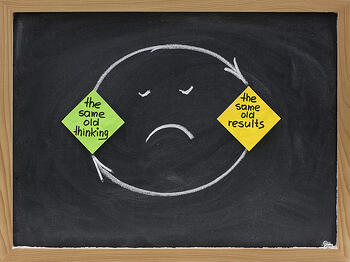Navigating the new “seller beware” world
 One of those “touchy-feely” expressions that emerged in the 1970s that so characterized that decade went something like this: “If you love someone, set them free, and they’ll come back to you.” Now, we’re no expert on the psychology of romance, but when applied to business, that philosophy actually has an enormous amount of merit. As we’ve discussed here many times, the key to succeeding in the new paradigm of sales is to accept the counter-intuitive philosophy that by giving up control you actually gain more.
One of those “touchy-feely” expressions that emerged in the 1970s that so characterized that decade went something like this: “If you love someone, set them free, and they’ll come back to you.” Now, we’re no expert on the psychology of romance, but when applied to business, that philosophy actually has an enormous amount of merit. As we’ve discussed here many times, the key to succeeding in the new paradigm of sales is to accept the counter-intuitive philosophy that by giving up control you actually gain more.
As the balance of power has shifted from a “buyer beware” to a “seller beware” world, the approach salespeople take has not adjusted accordingly. And sales processes, sales metrics and sales training all need to adapt as well if your salesforce is going to make a successful transition to this new world.
Phases of an old-school sales process traditionally break down like this:
- The first 20% of your time is spent determining if the prospect/customer is even capable of buying. While the salesperson may be doing some superficial needs assessment in this phase, it never goes deep to create value for the prospect.
- The next 30% of time is spent presenting, proposing and trying to convince your prospect/customer of your capabilities or the quality of your products.
- And finally, the remaining 50% of time is spent chasing down the prospect/customer, attempting to overcome objections, negotiate and close the deal.
Today, that pyramid should be inverted, with the initial 50% of effort (or more) being devoted to delving into your prospect’s enterprise and diagnosing their problems and needs. At first glance, the salesperson’s new mantra must be, “stop selling, start helping.” Begin helping the customer better understand their problems, the causes of those problems and what that problem is costing them when left unaddressed.
Where that final phase of the old sales process once seemed so essential, it is now the initial phase that is most likely to ultimately lead to a sale. It’s imperative that your salesperson is creating value for the prospect immediately out of the gate. With millions of bytes of information available to a customer at a keystroke, the assumption, naturally, is that the consumer is more educated than ever. In fact, studies show that when problems and needs being researched have any complexity at all, the customer is more likely to confused than informed. An arsenal of facts and figures means very little without the proper context to make sense of them.
Blog posts, video posts, white papers and such must provide the prospect with actionable intelligence—information that is not only relevant, but progressively leads the customer to an educated decision about their needs and, ultimately, the solutions you will provide. By analyzing your customer’s footprints on your website, the information onsite with which they avail themselves and their corresponding response, you will glean as accurate a behavioral profile on them as technology will allow. Monitoring time spent on your site and where, as well as their responses to call-to-actions, your salesperson will be far better equipped to know when to reach out to the customer or provide them with supplemental resources.
Never assume that a prospect knows what he really needs, and never simply cater to what he thinks he wants. You won’t successfully serve him or yourself well at all. But once the prospect’s problem is clearly identified and understood, begin the next phase of the sales process: designing the solution. It’s at this juncture that you and the prospect should agree on the objectives that will define the success of your committing to do business together. Keep in mind, just as your customers don’t understand their problems, they certainly don’t know what’s possible or what they should expect. But by this stage of the process, your prospect/customer has stopped viewing you as a salesperson, and instead recognizes you as a critical resource to enable them to achieve those critical objectives you have mutually determined.
At this point, a handshake and a contract can be anticipated.
For the sales manager transitioning his or her salesforce to this new paradigm, remember these impact points.
- Tell your team to stop selling and start “advising.” The more your focus is on your products and services, the less likely you'll be valued or make a sale.
- The faster you try to get to the contract stage in your sales process, the less-likely you'll close a deal.
- The harder you work to prove your worth, the less likely it is you'll be valued. Inform, help and advise, and your value will become self-evident.
- Teach your sales team to follow and understand web analytics—the footprints and actions of customers on your site. These metrics in the diagnosis phase of the customer relationship are the most important to be observed and acted upon.
- Convince your salesforce to stop envisioning a rate of closing percentages as motivation. That approach is just a fantasy. Implement the measures we’ve discussed here and their closing rates will exceed any old-school sales expectations.

 Doug Davidoff
Doug Davidoff